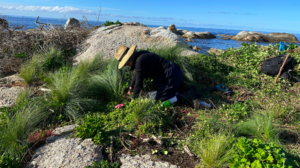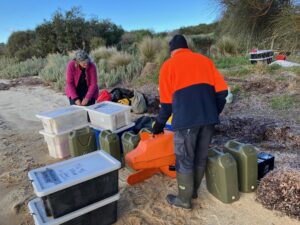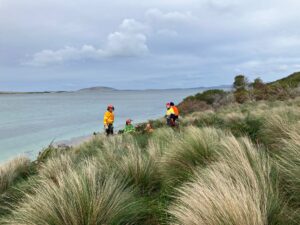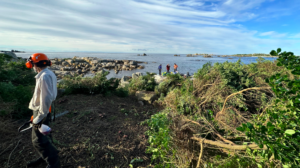Protecting biodiversity one island at a time
Tasmania has around 600 offshore islands and rocks, many of which are critical to seabirds for breeding and roosting. Being surrounded by the sea, offshore islands have a natural protective barrier. Even so, our islands are not immune to the impacts of pests, diseases, degradation and climate change. Twelve (20%) Wildcare groups are dedicated to the restoration of Tasmania’s offshore islands – carrying out important long-term rehabilitation and monitoring work.
Many islands in Tasmania can have biodiversity protected and restored through removal of invasive plants and vertebrate pests.
FURNEAUX ISLANDS
Friends of Bass Strait Islands have been methodically operating for over 20 years, successfully removing significant amounts of introduced plants from Bass Strait (read about their recent work here).
The successful removal of black rats on Big Green Island, on the western side of Flinders Island was one of the first volunteer-based vertebrate pest eradication projects. Over a period of several years the Tasmanian Parks and Wildlife Service, Biosecurity Tasmania, Wildcare and the Pennicott Foundation collaborated to successfully eradicate the rats. A national Froggatt Award from the Invasive Species Council was received in 2020 for this successful project.
The Friends of Fisher Island successfully removed house mouse from this tiny island and expanded their activities to successfully remove black rats from lana/George Rocks off larapuna/Eddystone Point then in 2020 commenced a major project to remove the invasive mirror bush.
In recognition of the need to undertake eradication projects on many offshore islands throughout the State, the Wildcare Seabird Island Restoration Group (SIRG) was formed to focus on the removal of vertebrate pest species (e.g. feral cats, rats, mice and rabbits) as well as weeds.
ISLAND BIOSECURITY
Dr. Sue Robinson (Scientific Adviser to SIRG) has been undertaking an assessment of islands around Tasmania. Sue’s day job with Biosecurity Tasmania (BT) gives her a good statewide perspective of the impacts of pests on islands. Sue explains some of her work addressing the impacts of pests on islands:
“Firstly we need to know which are our most important islands for seabirds and then which pest species are on these islands. Identification can be undertaken with motion sensing cameras, trapping or direct observation. Aerial drone surveys are often used for weed mapping. Plans are then developed for the removal of the pest species.
Different vertebrate pests require different techniques. Rodents can be trapped or baited, feral cats are usually targeted with cage traps first and the remainder with leg hold traps or shooting. For the rats at Big Green Island for example, over 2000 bait stations were deployed on a 25 x 25 m grid and regularly re-baited. Peanut butter chew cards were used to indicate remaining rats which were then targeted with snap traps. Monitoring continued for two years to ensure all rats are removed. Monitoring also included the use of trained rodent detection dogs.
Weeds such as mirror bush and boxthorn can significantly impact seabird breeding habitat resulting in difficulty in birds accessing nesting sites or raising chicks. Weed removal can be very labour intensive and more effective herbicides and techniques are now being investigated.
Biosecurity of islands is also a factor to consider when deciding whether to remove a pest. For vertebrate pests in particular, we need to be confident we can stop them from reinvading.”
- Little Dog Island
- Little Dog Island
Recently, Biosecurity Tasmania received a large grant from the Australian Government to assist with the removal of weeds and vertebrate pests from islands of high conservation value. Under this project numerous islands have been prioritised for pest management over three years, with many of these in the Furneaux Group. Wildcare volunteers, including those from Friends of Bass Strait Islands, SIRG and other groups have already been helping with this project on a variety of islands.
Dear Wildcare volunteers,
On behalf of Biosecurity Tasmania, I’d like to express our gratitude for the incredible work you have contributed this year to remove weeds from the islands within Franklin Sound (Little Dog, Briggs, Fisher) and out at Chappell and Little Badger Islands. Also, a big thank you to the North Barker and TAC teams. Through this amazing effort we have begun to restore some of Tasmania’s most important seabird breeding islands. We truly couldn’t have done it without you. I am grateful for the professionalism and dedication of the weeding teams which provide us with a high level of confidence that we will be successful in returning these precious islands to a near natural state.
Removal of invasive weeds from high priority islands is a long-term goal of Biosecurity Tasmania’s Offshore Island Pest Management project and we hope you will continue to help with this important conservation work. Through Friends of Bass Strait Islands and Seabird Island Restoration Group we will be organising more opportunities to become involved over the next three years. We would love to see you again.
If you have any feedback or questions about the on-going work, please don’t hesitate to contact me at Sue.Robinson@nre.tas.gov.au or give me a call on 0429 418 841.
Thanks again for all your hard work, support and, importantly, great company and humour.
Yours sincerely,
Sue Robinson.
SEABIRD ISLAND RESTORATION GROUP (SIRG)
Currently SIRG is focussed on removing mirror bush from lana/George Rocks, expanding on the work originally undertaken by Friends of Fisher Island. SIRG will continue to assist Biosecurity Tasmania with island-based work. SIRG will then use this momentum and experience to continue with vertebrate pest projects and the very important follow-up work required for weeds.
Beyond the obvious fieldwork, there are numerous jobs SIRG members can be involved in. For the island work to be successful in the long term, the group aims to raise public awareness, in particular amongst the boating community, about the risks of introducing pests to islands.
Leading by example, the group will be adopting best practice biosecurity measures whilst doing field work – similar to the excellent practices of the Friends of Bass Strait Islands and the Friends of Maatsuyker Island.
By connecting volunteers and experts, SIRG aims to protect island-based seabirds and their breeding habitat through:
- Vertebrate pest management and eradication
- Weed management including removal and on-going monitoring
- Supporting island biosecurity
As well as receiving support and advice from Sue Robinson, the group includes retired PWS and NCH staff with extensive island and wildlife experience and seabird biologist, Dr. Jez Bird.





